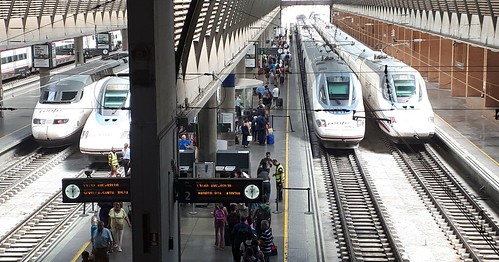EU Observer
By
PETER TEFFER
BRUSSELS, 26. JUN, 11:32, 2018
The EU has spent €23.7bn on high-speed railway projects since 2000, but this co-funding was of "low added value", the European Court of Auditors
said in a report on Tuesday (26 June).
It said it was "very unlikely" that a target for tripling the length of Europe's high-speed rail network by 2030 could be achieved, and that a pan-European approach is missing.
"The decision to build high-speed lines is often based on political considerations, and cost-benefit analyses are not used generally as a tool to support cost-efficient decision-making," said the report.
The researchers audited Austria, Germany, France, Italy, Portugal, and Spain – who together received 83.5 percent of all EU funding for high-speed railway lines since 2000.
The report's findings are highly relevant, not only because they raise questions about whether EU funding was spent effectively, but also as rail travel is being touted as a more climate-friendly alternative to flying.
The auditors found that domestic high-speed rail was competitive compared to aviation, but did not look at the difference between railway travel and low-cost flights between EU cities in different member states.
They concluded that there is no European high-speed rail network, "only a patchwork of national high-speed lines, planned and built by the member states in isolation".
According to the report, there was no proper coordination across borders, despite international agreements and EU legislation.
The European Commission set a target in a 2011 'white paper' to have a European high-speed rail network by 2030 that is more than 30,000 km long.
The auditors noted however that by the end of 2017, only 9,000 km of high-speed lines were operational, with 1,700 km under construction.
"We consider it unlikely that this target will be reached, because it takes around 16 years for high-speed rail infrastructure to be planned, built, and to begin operations," said the report.
In an advance response, attached to the report, the commission said that it still believed the 2030 target can be met.
"The commission remains committed to the conclusions and the identified measures following from the strategy outlined in the 2011 white paper and continues to put forward and implement the actions necessary to fulfil the objectives set out in the document," said the EU executive.
The court of auditors – which is not an actual court – noted however that the commission has "no legal tools and no powers in the decision making" to make sure that member state governments carry out the required plans to achieve its goal.
"We found that the EU's current long-term plan is not supported by credible analysis, is unlikely to be achieved, and lacks a solid EU-wide strategic approach," the auditors said.
The EU's financial contribution to the high-speed railway projects was "a small fraction" of the total investments member states made.
The court noted that high-speed rail projects tended to be marred with delays and overrun in costs.
Eight of the thirty projects which the court audited were delayed by at least one year, while five of the ten lines audited had experienced delays of more than a decade.
A stretch of 267km of high-speed railway between Germany's Stuttgart and Munich, for example, was estimated at €1.8bn, but ended up costing at least €13.3bn – with the line not completed yet.
The estimated costs for the 'Stuttgart 21' railway station was at €4.5bn in 2003, €6.5bn in 2013, and €8.2bn in January 2018.
"For this project, because of unrealistic initial cost estimates for tunnelling in a densely-populated city centre, and insufficient assessments of geological, environmental and local community cultural heritage aspects, construction costs have soared," said the report.
The original plan said that the Stuttgart construction works would be done by 2008 – they are now estimated to be finished by 2025.
Obligatory layovers
The auditors also noted that differences in national railway legislation are still causing obligatory layovers at borders – something which
they already warned about in 2010.
When travelling from France to Spain, travellers have to change platforms when crossing the border.
"Because most of the section between Bordeaux and the Spanish border is not a priority for France, infrastructure at the border remains antiquated, incompatible and poorly suited to a modern high-speed rail network," said the report.







